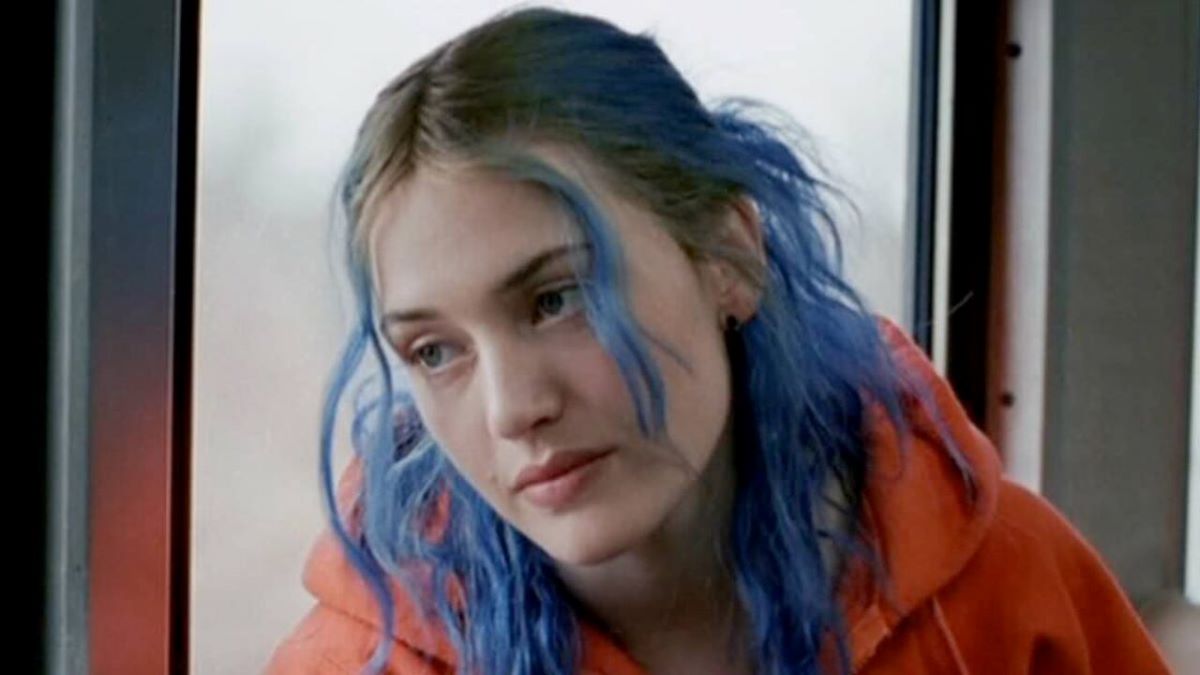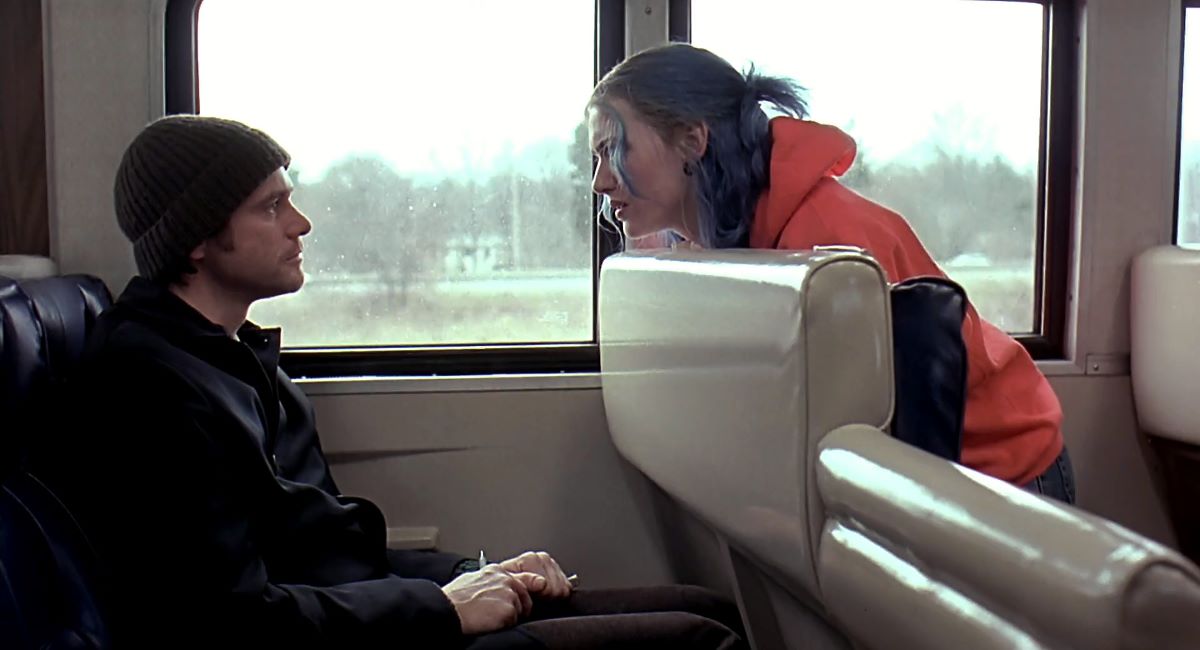It’s Been 20 Years Since ‘Eternal Sunshine’ Turned a Toxic Trope on Itself

Sci-fi romance Eternal Sunshine of the Spotless Mind turns twenty years old today, March 19, 2024. As a huge fan of sci-fi and romantic movies, this one’s always been a favorite. One of the best things about it is the way it uses and subverts one of the most misunderstood and toxic tropes in filmed narratives.
What’s Eternal Sunshine about?

Written by Charlie Kaufman (Adaptation, Being John Malkovich) and directed by Michel Gondry (The Science of Sleep), Eternal Sunshine stars an awesome cast led by Jim Carrey and Kate Winslet turning in career-highlight performances. Carrey plays Joel Barish, a mousy “nice guy” and chronic journal-keeper. Winslet plays Clementine Kruczynski, a brash, chaotic woman with frequently changing interests and hair colors.
The film opens with Joel finding out that Clementine has undergone a procedure that erased all memory of him from her mind when their tumultuous two-year relationship ended. Angry and hurt, Joel decides to erase her, too, and the film is a collection of his memories of their relationship as they are erased. As he’s undergoing the procedure, Joel has a change of heart and wants to call it off, so he takes the Clementine of his memory and attempts to hide her within other memories so she isn’t destroyed.
The “Manic Pixie Dream Girl”

Coined by film critic Nathan Rabin in his review of the 2005 Kirsten Dunst film Elizabethtown (she’s also in Eternal Sunshine), the “Manic Pixie Dream Girl” is “that bubbly, shallow cinematic creature that exists solely in the fevered imaginations of sensitive writer-directors to teach broodingly soulful young men to embrace life and its infinite mysteries and adventures.”
While I wouldn’t call her bubbly, Clementine certainly has similarities to the type of character designed to check all those other boxes. She inserts herself into Joel’s life with an insistent enthusiasm, challenges Joel by shoving him out of his very narrow comfort zone at every opportunity, and engages in whimsical activities like taking Joel out onto the frozen Charles River in Boston so they can lie on their backs and look up at the stars.
At one point, she even says that her biggest worry is that she isn’t living every second of her life to the fullest.
And Joel eats it up. Despite everything Clementine says and does being antithetical to who Joel is, he’s drawn to her anyway. She’s so many things he wishes he were. She’s teaching him how to live life. He wants a MPDG, and she’s it.
Yet, there’s a big difference between Clementine and other female characters dubbed MPDGs: Clementine knows what movie she’s in. She knows how she’s perceived, and it upsets her.
Clementine’s complexity

Eternal Sunshine is one of Kate Winslet’s most compelling performances in large part because she’s not playing one character, but three:
- Clementine Prime, the OG Clementine we encounter in flashbacks as Joel tells Dr. Howard Mierzwiak (Tom Wilkinson) the story of their relationship.
- Clementine 2.0, the Clementine with no memory of her relationship with Joel who bookends the film.
- Memory Clementine, the version of Clementine accompanying Joel through his memories, who’s entirely a creation of Joel’s.
Winslet deftly navigates these three personalities with subtlety and precision, lending each one agency and knowingness.
Clementine Prime is a piece of work. She’s boisterous, enthusiastic, and creative, but it isn’t always endearing. For every instance that Clementine Prime is insightful, she’s also capable of being vapid and self-absorbed. For every moment she’s kind and loving, she can also be mean and hurtful. In other words, she’s a complicated human being. Clementine is far from perfect.
The first Clementine we encounter is Clementine 2.0, who “meets” Joel on a train to Montauk. While she exhibits traits we’ve come to associate with being a MPDG, she also comes at Joel (a guy she’s trying to hit on) with a hostile energy. Upon introducing herself, she immediately warns against jokes about her name. She unapologetically takes up space, whether he seems comfortable with it or not, moving ever closer to him in the train car until she’s right up against him on his seat. Then, when he tries to get back to his journal, she punches him in the arm before sarcastically leaving him to it.
Sam in Garden State would never!
As we watch Clementine 2.0 deal with her increasing unease post-memory wipe, we not only see glimpses of Clementine Prime’s flaws, but we see Clementine 2.0 wrestling with and questioning those flaws. When she and Joel are finally made aware of what happened to the memory of their relationships and hear the recordings they each made talking trash about each other, there’s a shift in Clementine. She understands the kind of person she is, but when she hears herself played back to her, she also knows that she doesn’t want to be that way. She wants to be better, but is afraid she can’t be.
Memory Clementine is the version of Clementine that Joel remembers. She allows Joel to process his feelings about her, because she is Joel, made up of all his thoughts and feelings about her, and about himself. Of the three Clementines, she’s the most cartoony and comedic, making self-referential statements about her own quirks like, “You know me! I’m impulsive!” Memory Clementine is Clementine with Joel’s commentary track turned on.
Yet, while Memory Clementine is entirely Joel’s creation, it’s telling that we see the moments of her kindness, cleverness, and emotional intelligence shining through. While we know that Joel and Clementine were unhappy enough with each other to end their relationship, Memory Clementine is where we see Joel acknowledging that she wasn’t just her mean streak or her quirky personality traits. She was all of those things and also an insightful, creative, and loving person.
It took giving himself brain damage on purpose for him to see his ex-girlfriend as a nuanced human being.
Re-examining the “trope”

In 2014, seven years after initially coining the term in his Elizabethtown review, Rabin wrote an essay in Salon about coming to regret creating the term “Manic Pixie Dream Girl,” which has been criticized as being, in and of itself, sexist. While the term has taken on a life of its own, and has been applied (and misapplied) to countless female characters over the years, I think it can still be useful.
In order for the term to be useful, we have to go back to Rabin’s original definition, describing the MPDG as a “cinematic creature that exists solely in the fevered imaginations of sensitive writer-directors.” It isn’t that any quirky, twee woman in movies qualifies as a MPDG. It’s that MPDG are specifically created that way. On purpose. It’s wish fulfillment for the writer-director.
Zach Braff admitted as much even as he responded to backlash about Natalie Portman’s Sam character in 2004’s Garden State being a MPDG around the time of the film’s 10th Anniversary. While he respects the criticism of the character, he also flat-out says, “I was a very depressed young man who had this fantasy of a dream girl coming along and saving me from myself. And so I wrote that character.”
I myself am a quirky, boisterous woman with a fierce curiosity about new experiences and a youthful sensibility despite being in my 40s. I collect stickers, ffs. I’ve seen myself in lots of characters who’ve been dismissed as MPDGs (Jess on New Girl springs to mind). Critics accuse these characters of being poorly written and lacking nuance simply because they have interests and behaviors that don’t match up to what “real women” are like.
I, a Real Woman who is often like that, would find myself getting angry whenever a character I saw myself in would be dismissed in this way. But MPDG isn’t simply a blanket label for certain character attributes, nor is it simply a label for any poorly-written female character who only seems to be in the script to further a male protagonist’s story.
Eternal Sunshine, however, solidified what I think was Rabin’s original intention with the MPDG term by purposely and purposefully using the trappings of the MPDG while showing us the nuanced, complicated woman underneath.
In this film, Joel is the writer-director, and Clementine literally becomes the “creature that exists solely in [his] fevered imagination.” It’s a film where we see the male protagonist’s need for a MPDG in his life only to be confronted with the realization that, guess what? Those don’t actually exist. What does actually exist are women in all their varied humanity.
Complicated, nuanced, imperfect women.
Thank you, Charlie Kaufman, for writing us a film that examines men’s seeming need for MPDGs and how it can be harmful to men by denying them the opportunity to connect with the minds and hearts of real, flesh-and-blood women while chasing a fantasy.
(featured image: Focus Features)
Have a tip we should know? [email protected]